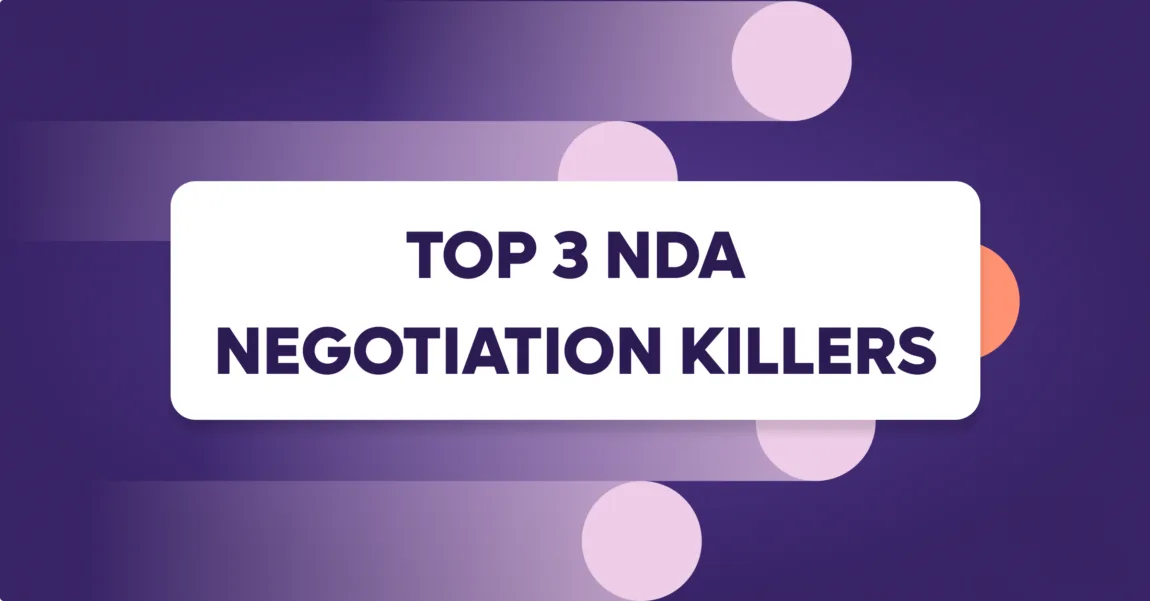NDAs are hands down the most common form of contract used by businesses, and there are so many different types of non disclosure agreements for a huge variety of purposes.
So what are they?!
Put simply, the purpose of an NDA is to protect information provided by one side to the other.
It is a confidentiality agreement that sets out the terms of how that information handed over can and cannot be used.
Let’s get one thing straight. Most NDAs are harmless.
Despite all that scary-looking legalese, there’s usually nothing in them that’s likely to hurt you or the other party.
An NDA just says ‘don’t use or disclose my confidential stuff’.
The parties are just starting to talk. There is no economic exchange and the interaction and relationship are pretty minimal.
So when it comes to issuing your own NDA – there’s some negotiation killers you need to avoid in your NDA templates if you want the agreement to:
a) be effective
b) be enforceable
c) match your counterparty’s expectations
d) align with industry standards and business needs
e) get signed!
The Superlegal AI results are in!

Superlegal’s AI has reviewed thousands of NDAs and unearthed some interesting facts about three concepts that simply don’t belong in NDAs: non-compete clauses, non-solicit clauses and indemnification clauses.
Superlegal’s AI flagged these concepts across thousands of non disclosure agreements, revealing the following data:
Non-compete clauses appeared in NDAs 5% of the time.
Non-solicit clauses appeared in NDAs 12% of the time.
Indemnification clauses appeared in NDAs 15% of the time.
Why you must avoid these 3 terms in NDAs
Many NDAs are based on templates that invite unnecessary rounds of negotiation due to positions that are unacceptable in the market.
These terms are completely non-standard in the context of non-disclosure agreements. They rarely appear in NDAs, but when they do, deleting them is critical to maintaining the ordinary course of business.
First off – these terms aren’t even enforceable!
So in the extremely rare circumstance that you and your counterparty end up in court over your NDA, anything deemed to be unreasonable is going to be immediately thrown out.
More importantly – if you approach the other party with an NDA template that contains these terms, they’re not going to accept the impact they will have on their business.
So you’ll reach a dead end in your contract negotiations!
If you’re trying to conduct a business in the tech, SaaS or startup industries and you include these clauses in your NDAs – the bottom line is:
No one is going to do business with you.
We’ve got everything you need to know about these top 3 NDA negotiation killers that you need to avoid if you’re going to get your NDA signed and get business done!
Top 3 NDA Negotiation Killers
1. Non-Compete
Imagine you’ve just made a new friend – maybe even a potential BFF. New Friend invites you to have coffee. That sounds nice. Only thing is, New Friend wants you to sign a document first – one that says you won’t have coffee with anyone else for two years.
Would you sign it?
Probably not.
With most business deals, there’s more at stake than coffee.
Asking your customers to agree to a non-compete is asking them to give up their economic freedom for something they haven’t even seen yet!
Non-compete clauses protect against your counterparty entering into or starting a similar profession or trade in competition against you.
Non-competes in the context of NDAs are just problematic, since they limit a person’s ability to earn a living – which in fact goes against laws about public policy.
Non-competes are most commonly seen in NDAs in the employment context, but they can sneak their way into business deals.
So even though these clauses crop up 5% of the time – they are totally irrelevant in the context of NDAs!
With the inclusion of this term, an otherwise-harmless NDA is transformed into a highly toxic non-compete agreement.
Non-competes aren’t even enforceable in all states or in all circumstances. Some states, such as California, consider non-compete clauses void in most circumstances.
But where non-competes are valid, they can cause major headaches for people who sign them.

2. Non-solicit
Non-solicitation clauses are unusual to be found in NDAs, appearing only 12% of the time according to Superlegal’s findings.
Not everything that’s unusual is bad, but in this case, it is!
Similarly to non-compete clauses, we’re talking about limiting basic economic freedoms – which is entirely out of place in the context of NDAs!
Non-solicitation clauses prohibit your customer from soliciting or otherwise inducing your employees to terminate their employment in order to work for them.
A non-solicitation clause is only really applicable in a contract between a company and one of its employees.
These clauses rarely appear in NDAs, but when they do, they are the most heavily negotiated provisions within a non-disclosure agreement.
But a business-minded court is going to be incredibly reluctant to enforce provisions that unreasonably limit a person’s ability to make a living, especially if the provision applies for an extended period of time or is unduly broad.
The biggest legal problem with non-solicitation agreements is that everyone has a right to work in a chosen profession. No one can legally force another person to be unemployed.
In California, a state Supreme Court ruling made all non-solicitation agreements unenforceable except to protect trade secrets.
So these clauses are at best unenforceable, and at worst, they’ll either take months to negotiate or simply won’t be agreed upon by your customers.
So include them in your non disclosure templates at your peril!
3. Indemnification
Fewer things in the legal world are less understood by lawyers than indemnities.
The burden of indemnification is a steep one.
Indemnity clauses represent a promise to compensate the other side from the risk of harm, liability or loss – a lot like insurance.
Let’s start by saying that indemnification does make sense in most commercial contracts.
Especially in circumstances including a substantial exchange of value and robust terms around liability and risk.
Indemnification is an inappropriate shifting of risk in this context.
But when it comes to commercial NDAs – even though the data shows that 15% of NDAs include indemnification terms – they should never include indemnity provisions.
Where indemnification clauses do creep their way into, they represent another huge sticking point in NDA negotiations.
The reason is that very few (if any) businesses would be willing to give an indemnity in favor of the disclosing party for breach of an NDA.
Regardless of the nature of the confidential information, the implications of breach and the risk associated with the contracting party:
Indemnification clauses should never be included in non-disclosure agreements!
There could be some potential advantages to being indemnified as the party disclosing the confidential information. Such as not necessarily being required to mitigate any loss, and the time periods for bringing a claim.
However, the absence of an indemnity does not restrict your ability to claim for damages or pursue other remedies (in the extremely rare case that something goes wrong!)
So not only are they inappropriate and most likely unenforceable, they are actually entirely unnecessary.
This is of course provided that your NDA template is correctly drafted!
Conclusion
NDAs can be heavily negotiated over a period of months. And if your non-disclosure agreements contain terms that are:
- off market standard
- onerous on your buyers
- not necessary to include
- ambiguous
- badly written
You’re going to invite endless rounds of negotiation that at best, waste you time and money, and at worst, lose you deals and customers!
Superlegal uses a combination of AI and top legal professionals to optimize your existing templates and review your contracts in one super simple platform!
And we do it faster and cheaper than any lawyer!
To get your first contract reviewed for FREE – click here!






By entering your email, you agree to our Terms & Conditions and Privacy Policy.